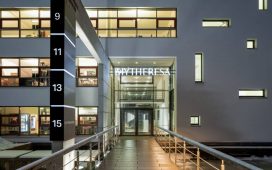As a student in the volatile May of
1968, Miuccia Prada took to the streets of Milan to demonstrate for women’s
rights wearing an Yves Saint Laurent suit.
Today, the 76-year-old reigns over a luxury goods empire worth more than
five billion euros ($5.4 billion) a year, with her world about to expand
further with the takeover of flamboyant rival Versace.
An avant-garde designer whose minimalist style belies its rebellious
nature, Prada has imprinted her elegant and intellectual sensibility on the
world of Italian fashion for decades.
As a young woman she wanted to become involved in politics, and took
courses in mime and theatre.
But she shelved those dreams in the early 1970s to devote herself, along
with her mother Luisa, to the leather goods boutique founded in 1913 by her
grandfather, Mario Prada.
“In the 1970s, as a left-wing woman, I was ashamed to make handbags, and I
was also ashamed because it was a profession that I liked very much,” she said
in 2022.
Born in Milan on May 10, 1948, into a bourgeois Catholic family, Prada has
become one of the wealthiest and most influential women in the world, with a
fortune estimated by Forbes magazine at 5.8 billion dollars.
A political science graduate and feminist activist who frequented Communist
circles, she eventually devoted herself body and soul to turning around the
family business, which had lost its lustre after the death of her grandfather
in 1958.
A monster of ambition
In 1977, Prada found a perfect partner in Patrizio Bertelli, a Tuscan
leather manufacturer she met at the Milan leather goods fair.
He helped her boost the finances of the boutique, over which she took
control in 1978.
Nine years later, the business partners married.
“He was the one who wanted to do something big. I told him I wasn’t
ambitious. He replied: ‘You’re a monster of ambition’. He was right,” she
said.
It was the starting point for Prada’s irresistible rise.
In the early 1980s, the designer broke new ground by creating a collection
of black nylon bags with a silky effect, which became all the rage.
She would go on 40 years later to champion nylon thread made from recycled
plastic recovered from the oceans.
The brand began growing, with boutiques springing up first in New York and
Madrid, then London, Paris and Tokyo.
Ironically, her first women’s ready-to-wear show in Milan in 1988, all in
black and white, was not well received, with critics considering it too
austere.
But her minimalist luxury, with its clean lines and somber colours,
eventually made its mark, winning over an international audience.
Breaking the codes
Federica Trotta Mureau, editor-in-chief of the Italian magazine Mia Le
Journal, told AFP that in tapping her fascination with art, architecture and
philosophy, Prada “created a free universe, a sort of experiment without
rules… aimed at breaking the codes of fashion”.
Prada says she has long worn vintage garments, while speaking out against
fast fashion, where quick production cycles churn out low-priced items that
are often soon disposed of.
Her signature garment has always been the skirt, with its infinite
variations.
Prada refuses to see women as “just beautiful figures”: “I don’t tend to
make super sexy clothes. I try to be creative in a way that can be worn, that
can be useful.”
A men’s collection was rolled out in 1993, the same year that saw the
launch of the Miu Miu brand appealing to younger customers — and borrowing
the designer’s nickname.
Sales of Miu Miu doubled in 2024, enabling Prada to weather the global
luxury crisis unscathed.(AFP)








